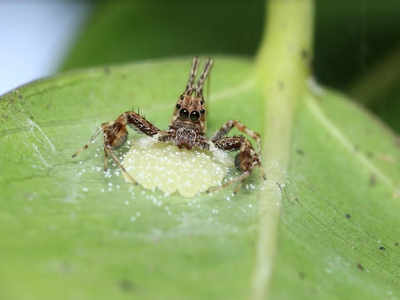
MANGALURU: Agriculturist and nature enthusiast Dr Abhijith APC has observed and documented a series of male and female Brettus cingulatus – a jumping spider over a 38 day period on a single leaf of a plant (Ficus microcarpa) at his Indraprastha Organic Farm, Mysuru.
Dr Abhijith is part of Team Saaliga, a group of like-minded individuals spreading awareness on spiders. He told TOI, “Most of these observations were centered on the activity of a succession of females, three of which occupied the underside of a single leaf, observed over a 38 day period. Field observation of salticids is difficult to follow as they get easily disturbed.”
In the paper, ‘notes on the jumping spider Brettus cingulatus in Karnataka’, published in Peckhamia, Dr Abhijith has documented 92 pictures. The paper is co-authored by David E Hill, USA. Brettus cingulatus is common throughout tropical Asia, from southern India to western Indonesia. They are known to feed on both insects and spiders, using at least five different modes of plucking with their pedipalps to entice web spiders to approach them.
Some of the observations recorded include female guarding her hatchling brood. At this stage, the young are dark green-black with light coloured legs, female guarding her eggs, penultimate female under leaf accompanied by adult male. Although the emergent spiderlings resemble the darker adult female, older ones of both sexes are light orange. An area of this leaf is occupied by the penultimate female, covered by a thin layer of silk. The same was occupied five days earlier by a different female guarding her eggs. The fate of that female and her brood is not known. As the female matures, the colour turns darker and adult pattern becomes more visible. There was a point when a female had deposited her clutch of 23 eggs and were not yet covered with silk, even at this point, she was accompanied by an adult male. Within 2-3 hours, the female covers her eggs with flecked silk- a character and Brettus. A male is still present, apparently watching the female. After mating, the female continues to guard her brood. On the next day, the female was gone and her fate is not known. There is a sequence that shows an ant removing an egg from the clutch, through an opening in the silk cover leaving 14 eggs behind. Eight other eggs were removed previously.
"New observations included regeneration of legs by a female at the final molt and a male mating with a female as she tended her eggs. Occupation of a single nest site by a succession of different females and the destruction of two different at the same site, one involving egg eating by ants is documented,” the authors have stated in their paper.
Dr Abhijith is part of Team Saaliga, a group of like-minded individuals spreading awareness on spiders. He told TOI, “Most of these observations were centered on the activity of a succession of females, three of which occupied the underside of a single leaf, observed over a 38 day period. Field observation of salticids is difficult to follow as they get easily disturbed.”
In the paper, ‘notes on the jumping spider Brettus cingulatus in Karnataka’, published in Peckhamia, Dr Abhijith has documented 92 pictures. The paper is co-authored by David E Hill, USA. Brettus cingulatus is common throughout tropical Asia, from southern India to western Indonesia. They are known to feed on both insects and spiders, using at least five different modes of plucking with their pedipalps to entice web spiders to approach them.
Some of the observations recorded include female guarding her hatchling brood. At this stage, the young are dark green-black with light coloured legs, female guarding her eggs, penultimate female under leaf accompanied by adult male. Although the emergent spiderlings resemble the darker adult female, older ones of both sexes are light orange. An area of this leaf is occupied by the penultimate female, covered by a thin layer of silk. The same was occupied five days earlier by a different female guarding her eggs. The fate of that female and her brood is not known. As the female matures, the colour turns darker and adult pattern becomes more visible. There was a point when a female had deposited her clutch of 23 eggs and were not yet covered with silk, even at this point, she was accompanied by an adult male. Within 2-3 hours, the female covers her eggs with flecked silk- a character and Brettus. A male is still present, apparently watching the female. After mating, the female continues to guard her brood. On the next day, the female was gone and her fate is not known. There is a sequence that shows an ant removing an egg from the clutch, through an opening in the silk cover leaving 14 eggs behind. Eight other eggs were removed previously.
"New observations included regeneration of legs by a female at the final molt and a male mating with a female as she tended her eggs. Occupation of a single nest site by a succession of different females and the destruction of two different at the same site, one involving egg eating by ants is documented,” the authors have stated in their paper.
World Cup 2019
Trending Topics
LATEST VIDEOS
More from TOI
Navbharat Times
Featured Today in Travel
Quick Links
Lok Sabha Election Schedule 2019Lok Sabha Election NewsDelhi Capitals teamMI team 2019Rajasthan Royals 2019RCB team 2019Maharashtra Lok Sabha ConstituenciesBJP Candidate ListBJP List 2019 TamilnaduShiv Sena List 2019AP BJP List 2019Mamata BanerjeeBJP List 2019 MaharashtraPriyanka GandhiBJP List 2019 KarnatakaAMMK Candidate List 2019BJP List 2019 WBLok Sabha Elections in Tamil NaduBSP List 2019 UPNews in TamilLok Sabha Poll 2019Satta Matka 2018PM ModiMahagathbandhanNagpur BJP Candidate ListChandrababu NaiduTamil Nadu ElectionsUrmila MatondkarNews in TeluguMadras High CourtTejashwi YadavArvind KejriwalTejasvi SuryaPawan KalyanArvind KejriwalYogi AdityanathJaya PradaSatta King 2019Srinagar encounter
Get the app







